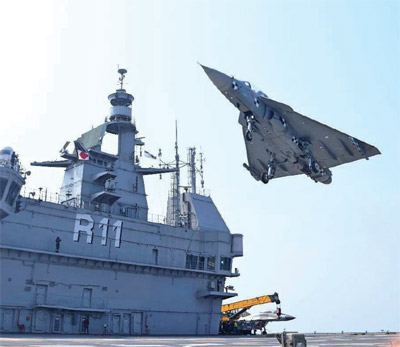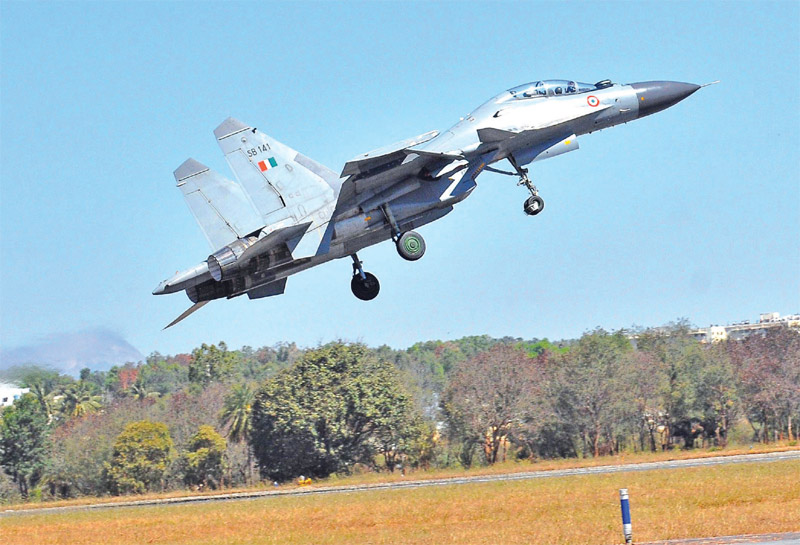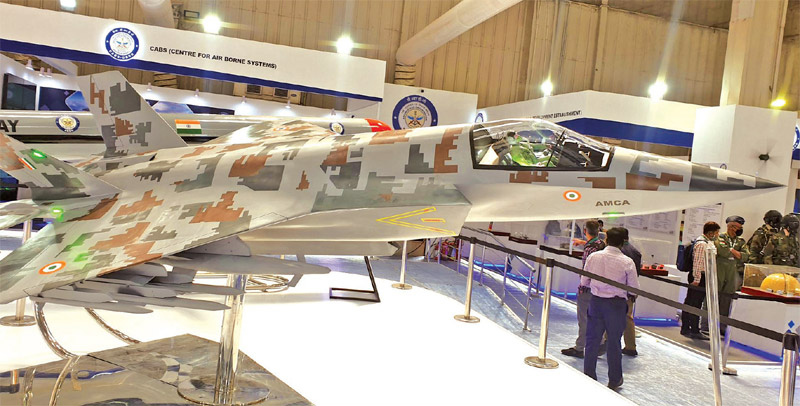Make in India policy and bureaucracy stalling procurement of modern jets
 Gp Capt. A.K. Sachdev (retd)
Gp Capt. A.K. Sachdev (retd)
In February 2014, when the fighter squadron strength of the Indian Air Force (IAF) was down to 34, the air force had declared to the Parliamentary Committee on Defence that managing a two front war would be a challenge. Two years later with the squadron strength having dropped to 33, the then Vice Chief of Air Staff Air Marshal Birender Singh Dhanoa (later Chief of Air Staff) told the media that “our numbers are not adequate to fully execute an air campaign in a two-front scenario.” If there was any doubt about the IAF’s ability to conduct a two-front campaign, it was convincingly told in 2018 when that year’s edition of Exercise Gagan Shakti unfolded.
While the ostensible and stated objective was to practise for a two-front war, the exercise was conducted serially on two fronts, one after the other. While the first phase focused on India’s western borders in terms of deployment and operations, the second phase saw the same assets shifting to the northern borders. Thus, the exercise convincingly and credibly substantiated the IAF’s inability to conduct a two-front war. Five years down the line, the IAF’s squadron strength has dwindled to 31, less than three fourths of the sanctioned strength of 42 (an RTI query raised by this author seeking details of the document sanctioning 42 squadrons is being passed between Air HQ and the ministry of defence with both not appearing to know the answer).
Present Fleet
The latest MiG-21 accident on 8 May 2023 in Hanumangarh, Rajasthan, in which three civilians lost their lives led to the temporary grounding of the surviving three MiG-21 squadrons of the IAF. Besides these three squadrons, the IAF has in its inventory 12 squadrons of Su-30 MKI, six of Jaguar, three each of MiG-29 and Mirage 2000, two of Rafale (the last aircraft arrived in December last year) and two of Tejas (which are of limited operational capability and lack a trainer).
Of these, the three grounded MiG-21 squadrons are planned to be phased out gradually by 2025 while the Jaguar fleet will be phased out between 2025 and 2032. The MiG-29 and Mirage 2000 squadrons, whose induction began in the 1980s, would be finishing their lives by then and retired from service gradually until all are out of service by 2040. It is quite possible though that the IAF decides to continue squeezing some more years out of them (as in the case of the MiG-21, which started off as the pride of the IAF in the 1960s). The MiG-29s, Mirage 2000s and Jaguars are already operating on extended lifecycles.

The MiG-29s were inducted in 1986 and had a life cycle of 25 years, which was later extended during the mid-2000s to 40 years. This extension will expire starting in 2026 and a second life extension programme for the MiG-29 fleet is being contemplated in view of the grim situation. The Mirage 2000s are not being given another extension but as they have been retired by the French Air and Space Force, India has contracted to acquire 24 phased out Mirage 2000s from France for the purpose of cannibalising spares and components, thus giving an extension of sorts to the ageing IAF fleet.
The Jaguars were inducted into the IAF in 1978 and were later produced in India by the Hindustan Aeronautics Limited (HAL) under licence. With fair use, the thrust of the original engines has reduced by around 20 per cent and replacement engines are horrendously expensive at over Rs 200 crore a pair. Meanwhile, plans to install an Indian engine have been still borne as India has not produced any worthwhile engine so far. Thus, another upgrade is not considered wise and the IAF continues to milk the last dregs of life from the aircraft.
There were plans to add one MiG-29 and two Su-30 MKI squadrons but the Russia-Ukraine war has played spoilsport. It does not appear that there will be any reprieve on that front as even after the hostilities come to an end, the battered industrial complexes of both Russia and Ukraine will take time to recover and in any case, will meet their own national requirements first before looking to export aircraft. Plans to upgrade 85 of the existing Su-30 MKIs with Russian help to Su-30 SM2 standard have also been deferred. As a result, there has been some talk of an upgrade on these aircraft to be done at the HAL itself.
Looking into the near future, it is certain that the squadron strength will fall further before it starts an upward climb towards the sanctioned strength of 42. The Chief of Air Staff is on record as having stated (during Exercise GARUDA VII in October 2022) that the IAF requires five to six new squadrons of 4½ generation aircraft to meet its immediate requirements. Let us explore where these could be procured from.
Indigenous Designs
It is an open secret that the Light Combat Aircraft (LCA) Tejas Mk1 was forced upon the IAF in the government’s push for Make in India and Aatmanirbhar. The aircraft was not ready for frontline induction and continues to be just a testbed for the Mk1A, which is a slight improvement over the Mk1. But the IAF has 40 Mk1s and these count as two (albeit non-effective) squadrons of the IAF’s 31.
In June 2021, the IAF ordered 73 Mk1As and 10 Mk1 trainers (which were not developed alongside the Mk1). Of these, the HAL is to deliver the first three aircraft in 2024 and, thereafter, 16 every year for the next five years, taking the total to 83. The Mk1A is expected to come with more composites (and hence reduced weight), enhanced Electronic Warfare (EW) capability, the indigenous Uttam Active Electronically Scanned Array (AESA) radar (which the DRDO is to make available by the time the 17th Mk1A is to be fitted with it as the first 16 Mk1As are planned to be fitted with the Israeli ELM 2052 AESA radars). It will also carry the locally assembled, European missile producer MBDA’s Advanced Short Range Air-to-Air Missile (ASRAAM) and the indigenously developed Astra Beyond Visual Range (BVR) missile. It will also have some other improvements including air-to-air refuelling capability.

What will really bolster the IAF’s inventory meaningfully would be the Tejas Mk2, hopefully a 4 and 1/2 generation Medium Weight Fighter (MWF). The Tejas in its name is misleading inasmuch as the Tejas Mk1/Mk1A is a ‘light’ fighter while the Mk2 is a ‘medium weight’ aircraft with a Maximum Take Off Weight (MTOW) of 17.5 tons compared to Mk1A’s 13.5 tons, a more powerful engine (although still a General Electric (GE) engine and not an indigenous one), and a larger payload of 6.5 tons compared to a little over 4 tons for Mk1A. The IAF has committed to acquiring six squadrons of Tejas Mk2 but, given the HAL’s track record, it could take many more years to be ready. Last year, the Cabinet Committee on Security cleared Rs 6,500 crore for the Mk2 but actual disbursement is yet to occur. Meanwhile, 73 Mk1As are expected to be inducted between 2025 and 2029, again a bit doubtful given the HAL’s past.
The Advanced Medium Combat Aircraft (AMCA) is planned to be a twin engine, fifth generation aircraft in contrast to the Tejas Mk1/Mk1A LCA and the Tejas Mk2 MWF, both of which are single engine, 4th to 4½th generation fighters. The AMCA was originally envisaged as a Medium Combat Aircraft (MCA) with an MTOW of 15 tons but subsequently its nomenclature was changed to the AMCA and its MTOW upped significantly to 25 tons (with the Tejas Mk2 sliding into the 15 ton space). A power plant for it remains uncertain as India has produced none so far. The AMCA may fly with a GE engine (like the Tejas). An indigenous AESA radar is not yet a certainty and the stealth technologies and some other minor but critical elements needed as essential criteria for fifth generation are not also available indigenously. A first flight, slated for 2025, may well slide into 2030 as the CCS is yet to give the go ahead for its development. The Chief of Air Staff has reportedly called for foreign collaboration for the development of niche technologies for the AMCA and has expressed concern over the timely delivery of the AMCA. The IAF plans to procure seven squadrons of the AMCA, the first two squadrons in Mark1 configuration equipped with a GE engine, and the remaining five squadrons in Mark2 configuration with an indigenous engine. But the AMCA is not going to immediately fill the shortfall problem of the IAF in a hurry.
A 23-ton, twin engine, medium class Omni Role Combat Aircraft (ORCA) is also spoken of sporadically, but it will come later than the AMCA and hence will not be a help any time soon. To summarise, an indigenous 4 and 1/2 or 5th generation aircraft that meets the IAF’s needs is unlikely to be inducted into the force before 2040.
Multi role fighter aircraft
A Request For Information (RFI) was floated in 2004 for the purchase of 126 Medium Multi-Role Combat Aircraft (MMRCA) possessing 4.5 generation capabilities with the stated intent of inducting the first aircraft by 2010. After a torturous journey, it was scrapped altogether in 2015 and a memorandum of understanding (MoU) was signed in 2016 for only 36 Rafales.

In April 2018, an RFI was promulgated by ministry of defence for the acquisition of 110 aircraft (the figure was later revised to 114). The RFI did not specify whether the requirement was for a single engine aircraft or a dual engine one and prescribed six roles for the multi role aircraft. Seven Original Equipment Manufacturers (OEMs) responded. These were the Eurofighter (Typhoon), France’s Dassault Aviation (Rafale F3R), Saab (Gripen-E), Russia’s United Aircraft Corporation and Sukhoi Corporation (MiG-35 ‘Fulcrum-F’ and Su35 ‘Flanker-E’) and US’s Boeing and Lockheed Martin (F/A-18E/F ‘Super Hornet’ and upgraded F-21). However, there does not seem to be a great deal of urgency attending the processing of this 114 Multi Role Fighter Aircraft (MRFA) deal.
Five years have passed since the RFI but there is no indication that a Request For Proposal (RFP) is nigh. One major reason for the delay is the government’s insistence on commitments to Aatmanirbhar and Make in India. The deal was originally being processed through the Strategic Partnership framework, which implied that an Indian company would partner with a foreign supplier to manufacture major platforms in India. However, with lukewarm interest from foreign OEMs and keeping in view the poor success that past Strategic Partnership attempts have had, the government is now in favour of ‘Buy Global, Make in India’ approach.
While the IAF waits with anxiety, the government has shown no hurry to process the deal over the last five years and is still evaluating the responses to the RFI, a sad comment on the nation’s defence preparedness. Interestingly, there is no defined deadline for the MRFA programme! One hopes that the MRFA does not drag on and then get buried alongside the MMRCA.
Dwindling Numbers
It is evident that the current figure of 31 squadrons will reduce to between 28 and 30 (with MiG-21 de-induction) before it stabilises and starts inching up over the coming years. A steady flow of Tejas Mk 1As will add to the inventory provided the HAL is able to adhere to agreed schedules. If the 114 MRFA deal materialises and the aircraft deliveries start before 2025 (improbable but not impossible), the figure could be arrested at 31 and built upon. The Chief of Air Staff has often stated that in the best scenario, he expects 12 squadrons to be inducted between now and 2035 which should take the squadron strength to 35 or 36, depending on how the de-inductions proceed. An optimistic projection for the IAF to reach 42 squadrons is 2040.

Conclusion
In any case the figure of 42 has been around for many years and will probably need a relook if and when we achieve it. Frequently, we hear the argument that when 42 squadrons were sanctioned, we had only third generation fighters. Now that we have 4th and 4 and ½ generation combat aircraft so we should be able to manage with a lower number of squadrons.
However, given the large geographical area the IAF needs to cater to, quantity matters as much as quality and one cannot compensate for the other. Despite the huge cost of fifth generation fighters, air forces inducting them are not pruning their fleet sizes. On the contrary one could argue that given India’s ambitions to be a world power, its interests may extend beyond its own territorial bounds and so the sanctioned strength needs to be increased.
Space constraints do not permit an appraisal of the Chinese air threat but suffice it to say that the Peoples’ Liberation Army Air Force (PLAAF) is not an ‘Army’ air force any more but one with strategic reach and a constantly increasing inventory of 4th and 4 and 1/2 generation fighters as also modern bombers. The IAF’s capability on the other hand is regressing.
An unrealistic confidence in foreign policy’s ability to avert war appears to be guiding the delay in the MRFA procurement process, which has stagnated over the last five years. The compulsion to promote Make in India and Aatmanirbhar, even at the cost of a depleted squadron strength, appears to be compounding the problem. The fact that despite seven decades of investment and infrastructure building, our R&D set-up has not been able to produce an indigenous engine for our aircraft programme is a tragic situation our aerospace industry finds itself in. An air of optimism prevails that the Prime Minister’s visits to the US and France may bring some good news on GE or Safran collaborating with India on aeroengine design and development.
The major reason for the government to be dragging its feet over the MRFA is financial constraint. Last year’s defence budget dropped below 2 per cent for the first time in decades. Budgetary allocations have been barely adequate to meet committed liabilities. Clearly, the outlay on defence of the nation is on low priority, in any case lower than some avoidable expenditures of the government.
There can be no two opinions about the critical need for 4th and 4 and 1/2 generation fighters for the IAF. The IAF ought to be making more noise about it but perhaps it has already cried itself hoarse trying to expedite the MRFA deal. While the government is now preoccupied with the impending general elections in 2024, the bureaucracy is busy doing to the MRFA what it does best. delay the process. The Chief of Defence Staff lacks any say in the matter, there is no national security policy in place and the responsibility of the nation’s defence is a grey area. The only certainty is that if the IAF meets ignominy in the next war, the blame will be laid squarely on the IAF’s shoulders.

